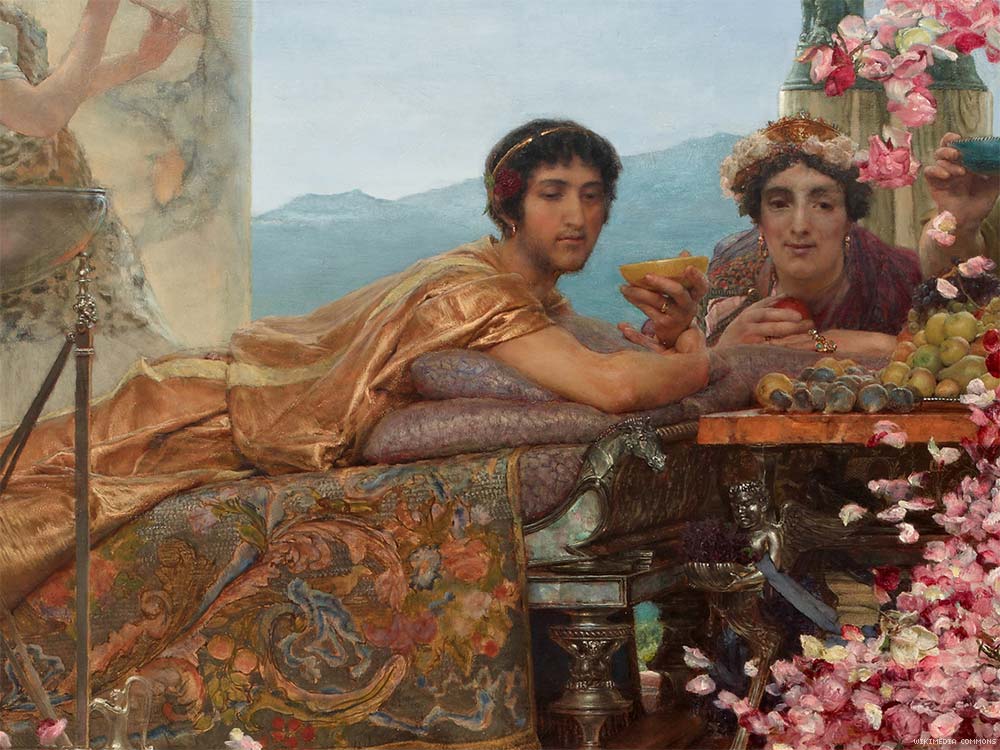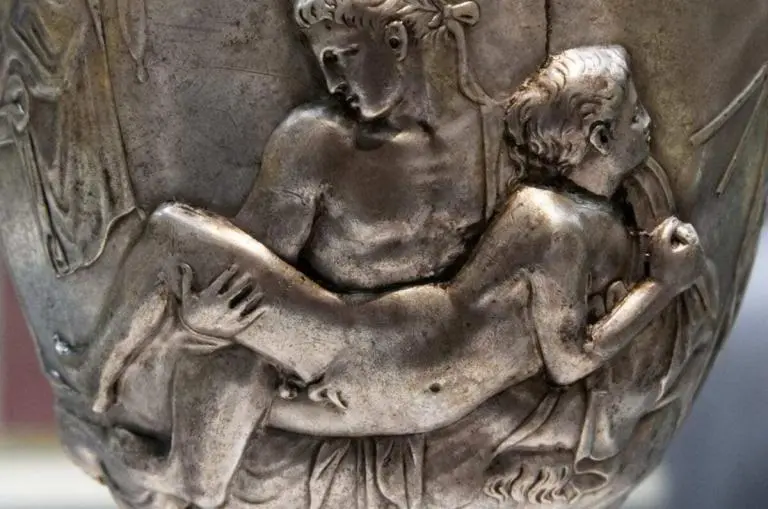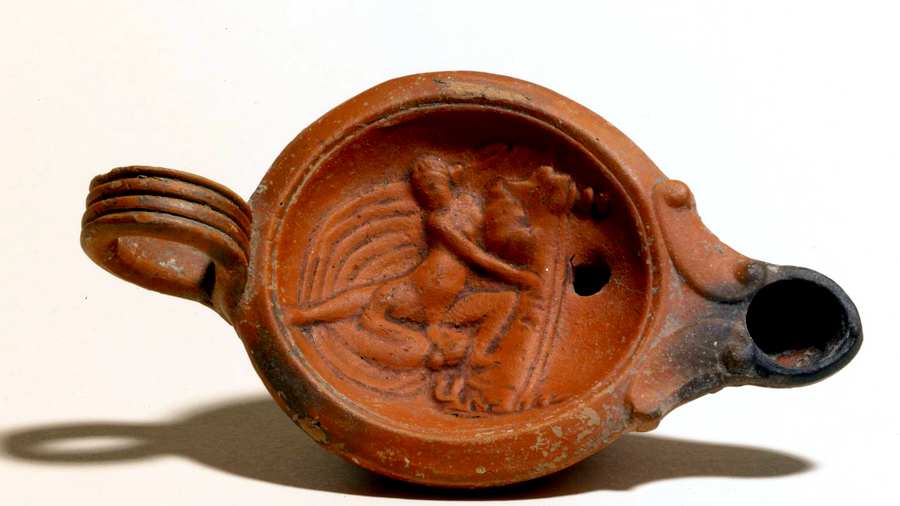Originally posted 2023-01-12 20:07:26.
Perhaps incredibly, Roman sex remains the standard model in most of the world. It is only the Benighted West that thinks it’s different.

There was no equivalent, anywhere in the Ancient World, to modern concepts like ‘gay’. There was a class of males usually called cinaidus or catamite, and these were exactly equivalent to the modern Homosexual, highly feminised, submissive, receptive in sex and often dressing as women.
‘Same-sex’ intercourse was commonplace and indeed, enthusiastically pursued, but only according to social conventions. Breaking these would incur no criminal penalty but the culprits might be shunned or excluded from society. This, in Rome, was a severe penalty.
[kofi]
Roman sex was dictated by two sets of rules. The first set was known as the mos maiorum , which translates to “the way of the elders”. It was an unwritten code of honour.
These rules were not codified but in essence stated a good Roman man should fornicate as much and with whomever he wanted, as long as he didn’t do anything too deplorable. However, free-born Roman men always took an active role during sex. They were always the penetrators.
For women, mos maiorum meant being chaste and only having sex with their husbands. It also meant sex was for the husbands’ enjoyment; female enjoyment wasn’t a consideration. However we know that Roman women took pleasure in sex both with men and with each other.
The second set of rules for Roman sex was of codified laws. These supposedly treated men and women equally; however, they were mainly there to protect the interests of free-born Roman men.

For the most part, at least until the Christian Imperial era, there was a strict separation between the State and what people did behind closed doors. There were four things that Roman law was interested in concerning Roman sex:
Incestum: Violating a family member, free-born Roman citizen, Vestal Virgin, or anyone who had made a vow of celibacy was illegal. One law covering this was the celebrated Lex Scantinia. Unfortunately all copies of this law have been lost so we have little idea of what it actually said.
Castitas: This law protected women who had chosen a life of chastity. For example, if a Vestal Virgin tried to break her vow, she would face a severe penalty. More often than not it was death.
Raptus: This covered abduction and kidnappings where the goal was to have sex with your victim. The law also persecuted the victim if they were willing participants, however. For example, if a young woman eloped without her father’s consent she and the groom could both face charges under raptus.
Stuprum: This covered rape and adultery. The rape of a free-born Roman citizen was taken incredibly seriously. It was seen as an assault on the Roman Empire itself. Likewise, an extramarital affair with a married Roman citizen undermined the family values which underpinned the Empire.
Again, the Lex Scantinia penalised stuprum against a freeborn male minor (ingenuus or praetextatus).
[kofi]
The age of majority for Roman sex, essentially that at which individuals could marry, was twelve for girls and fourteen for boys. However, the protection of female virginity was taken far more seriously. They were expected to be virgins at marriage. Boys certainly were not.
Nevertheless, as the following shows, the age rule was largely ignored.
an astonishingly large number of sources show…(that) underage marriages were often …full Roman weddings including the signing of dowry agreements, as well as the move of the new “wife” from her parental home to that of her “husband.” … One startling example is a passage of Ulpian (D. 48.5.14.8) describing (a girl under twelve) who had undergone a marriage ceremony and was residing in her “husband’s” home, where she had sexual relations with another man; the issue was whether, in light of the void marriage, the “husband” could accuse her of adultery.
Bruce Frier
https://classicalstudies.org/roman-law-and-marriage-underage-girls
Boys were expected to experiment sexually, either by penetrating younger boys or by being sexually receptive to older men. The focus of the Lex Scantinia was on involuntary sex, as far as boys were concerned.
Scantinia may also have been used to prosecute adult male citizens who willingly took a passive role in having sex with other men. It was thus aimed at protecting the citizen’s body from sexual abuse (stuprum), but did not prohibit same-sex coitus as such, as long as the passive partner was not a citizen in good standing. In practice, this meant that a free-born Roman could penetrate any other male who was not free-born. Slaves in particular had no protection whatsoever.

In general, then, Roman men had few impediments on whom they penetrated; the primary rule was that they should never be penetrated. However, this rule was at best patchy in its observance, as this pithy verse from Martial makes clear:
Your boy’s cock hurts; your arse is sore. I’m no seer
But what you’re doing, Naevolus, is clear.
Same-sex coitus was both legal and common in Roman sex. In reality, though, sexual activity for males was tied to views of what Romans deemed to be “masculine”. Roman sex did not allow for notions of ‘egalitarianism’. On the other hand, there was apparently no taboo whatsoever about anal sex, at least for the penetrator and it would appear that a large fraction of Roman men were both familiar with it and enjoyed it.
[kofi]
It was a man’s job to procreate; therefore, men were penetrators. Anyone who wasn’t a penetrator was seen as weak and submissive. Anyone who took the passive role in sex was seen as lower and might gain the epithet catamite. This meant that male sex with other males was fine as long as you were the penetrator or ‘active’ partner.
Any free-born adult male Roman citizen who allowed himself to be penetrated was likely to be shunned. There was even a slang term for it; Gaius Lucilius, a satirist, described any free-born man who took the passive role as a scultimidonus, which translates to “arsehole bestower”. A free-born Roman man, in this context an adult male, could lose everything if he was found to be a scultimidonus.
Sex between males in the army also came with some harsh penalties. The Greek historian Polybius recorded that sex between soldiers was punished by fustuarium, or death by clubbing. Commanders believed that soldiers entering same-sex relationships with each other would be bad for military discipline. For the same reason, legionaries were not permitted to marry women.
On the other hand, Roman legionaries could have intercourse with any slave, prostitute, or captive they came across. Indeed, the raping of male captives was a common way to show off a soldier’s sexual authority and masculinity.

Slave-markets
There were special slave-markets in Rome and other Roman cities which specialised in the supply of boy-slaves, who would serve as concubines. These often worked in the bath-houses as ‘towel-boys,’ in households or even the equivalent of bars, as ‘wine-boys’. However their real function was to serve as casual sexual partners to the men — and sometimes the women.
[kofi]
Legionaries were famous both for buying slave-boys to take on campaign and kidnapping or buying boys while they were there; it was not all uncommon for poor families to sell boys to serve as concubines.

In a nutshell, same-sex activity in ancient Roman sex was no big deal if you were a free-born male who liked taking the active role. Women, however, found to take part in same-sex relations usually faced some opprobrium, possibly because of the absence of penetration, which in Roman sex was essential. Since no penis was involved, this offended social mores. But again, lesbianism was common in Rome, both between free women and slaves.
Tribads (lesbians) are more eager to lie with women than with men: in fact they pursue women with almost masculine jealousy, and when they are freed of temporarily relieved of their passion…They rush, as if victims of continual intoxication, to new forms of lust, and sustained by this disgraceful mode of life, they rejoice in the abuse of their sexual powers.
Soranus, On Pathic Men

Even if a woman was thought to penetrate her female sexual partner, for example with the use of a dildo, this was still frowned upon. It was thought that the woman was taking the man’s role, probably dressed like a man, and likely wanted to penetrate men too. In Aristophanes’ anti-war comedy Lysistrata, women discuss using and sharing dildos while withholding sex from their partners in an effort to stop a war. However, the discovery of double-ended dildos suggests that women were using them to penetrate each other.

Of course, the Roman Empire was not static and one of the largest changes it went through was the shift from a polytheistic pagan religion to Christianity. Unsurprisingly, this had a major impact on how Roman sex was viewed within the empire. The difference between the old religion, which celebrated sex, and the much more conservative views of Christianity meant that Rome became increasingly conservative.
[kofi]
In the early Imperial years, same-sex weddings were not technically recognised by Roman law but appear to have been common. In the 3rd century AD, Emperor Elagabalus married a young athlete named Zoticus in a public ceremony. Emperor Nero famously married a boy-slave called Sporus and had him castrated, to prevent masculinity. The Emperor Hadrian may have married his lover, a youth from Bithynia called Antinous. It’s unlikely, since Emperors set the social mores for the society, that other Romans did not do the same.

These marriages were never between ‘equals’. Although Elegabalus was male, she married as a woman — thereby increasing the people’s dislike of her. Sporus — a boy sex-slave — was married as a woman and Antinous was understood to be the Emperor’s catamite — and so the relationship conferred no contumely on Hadrian, the penetrator.
In 390 AD, all same-ex coitus was declared illegal. Any free-born Roman caught indulging in it could be punished by burning. The dark days of Christian sexual repression had begun.

Slaves in Roman sex
Being a slave in Rome was not always unpleasant; it depended on the nature of the master. Some were manumitted by their owners after a period of service, others freed in the owner’s will, usually with a handsome stipend. On the other hand, a slave was property and nothing else. An owner could do whatever he liked to his slaves. This included demanding sexual services of the slave, who was bound to comply. This was an everyday part of life.
Young boy slaves were often described as puer delicatus or deliciae which translates to ‘sweet boy’ or ‘dainties’. Sporus, the eventual bride of Nero, was one such. These boys were used for sex by their owners and the owner’s friends. Because slaves had no rights or honour, they could be obliged to provide services that no Roman wife would.

Often a puer delicatus would be castrated and dressed as a young girl. The castration was to prevent puberty, keeping the boys young and feminine looking. The trade in young eunuchs was big business, not only in Rome but across the Ancient World. The growing taste for young boys soon became a problem, and the Senate had to become involved.
Eventually it passed legislation that banned the castration of slaves against their will for “lust or gain”. This was not done to protect the slaves but because the Senate believed that the unbridled lust that men displayed towards their boy slaves broke the mos maiorum, the unwritten code of Roman honour, which insisted that masculinity was characterised by self-control. The rapidly increasing trade in castrated boys for sex was seen as an excessive indulgence that the mos maiorum frowned upon.
[kofi]

Why not read this next?






One Reply to “Roman sex was the right kind of sex — and it still is”